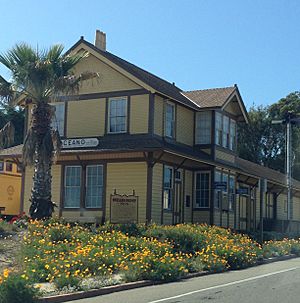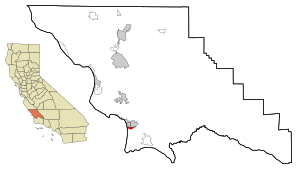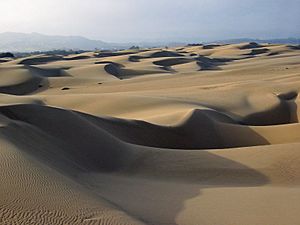Oceano, California facts for kids
Quick facts for kids
Oceano
|
|
|---|---|

Oceano Depot
|
|

Location in San Luis Obispo County and the state of California
|
|
| Country | |
| State | |
| County | San Luis Obispo |
| Area | |
| • Total | 1.547 sq mi (4.006 km2) |
| • Land | 1.532 sq mi (3.967 km2) |
| • Water | 0.015 sq mi (0.039 km2) 0.98% |
| Elevation | 30 ft (9 m) |
| Population | |
| • Total | 7,183 |
| • Density | 4,643.2/sq mi (1,793.1/km2) |
| Time zone | UTC-8 (Pacific) |
| • Summer (DST) | UTC-7 (PDT) |
| ZIP codes |
93445, 93475
|
| Area code | 805 |
| FIPS code | 06-53294 |
| GNIS feature ID | 1652760 |
Oceano (which means "Ocean" in Spanish) is a small community located in San Luis Obispo County, California, United States. It is known as a census-designated place (CDP). This means it's a special area defined by the government for counting people, but it's not an official city or town.
In 2020, about 7,183 people lived in Oceano. The community is part of the larger "5 Cities Metropolitan Area."
Contents
Exploring Oceano's Location and Landscape
Oceano is found at a specific spot on the map: 35.102680 degrees North and -120.611471 degrees West. It covers a total area of about 1.5 square miles (4 square kilometers). Most of this area is land, with a very small part being water.
The Famous Oceano Dunes
One of the most exciting parts of Oceano is its beach, which is called the Oceano Dunes State Vehicular Recreation Area. This area is a huge coastal sand dune system, covering about 1,500 acres (6 square kilometers).
It's the only state park in California where people can drive their vehicles right on the beach! This unique feature attracts many tourists from all over the United States.
Fun Activities at Oceano Dunes
There are lots of fun things to do at Oceano Dunes:
- Riding all-terrain-vehicles (ATVs) on the sand dunes.
- Swimming in the ocean.
- Looking for clams (this is called clamming).
- Camping right on the beach.
- Surfing the waves.
- Fishing from the shore (surf fishing).
- Hiking through the sandy landscape.
- Watching different kinds of birds.
Who Lives in Oceano?
The community of Oceano is home to a diverse group of people.
Population in 2010
In 2010, the population of Oceano was 7,286 people. About 70% of the residents were White. There were also people of African American, Native American, Asian, and Pacific Islander backgrounds. A significant portion, about 48%, identified as Hispanic or Latino.
Most people in Oceano live in family homes. In 2010, there were 2,603 households. Many of these households (about 35%) had children under 18 living in them. The average household had about 2.8 people.
The ages of people in Oceano varied widely. About 24% of the population was under 18 years old. About 12% of the people were 65 years or older. The average age in Oceano was around 35.4 years.
Population in 2000
Back in 2000, Oceano had 7,260 people. The racial makeup was similar to 2010, with about 69% White residents. About 45% of the population identified as Hispanic or Latino.
The average household size was a bit larger in 2000, with about 2.96 people per home. The average age was 32 years.
A Glimpse into Oceano's Past
Oceano has an interesting history, including being home to unique communities.
The Halcyon Community
In 1903, a special religious community called "Halcyon" was started in the Oceano area. This group was part of a spiritual movement called theosophy. They believed in using unseen energy to help people become better.
The community built several important buildings, including the Blue Star Memorial Temple and the Halcyon Hotel and Sanatorium.
The First U.S. Vegan Society
Oceano was also the birthplace of the first vegan society in the United States! In 1948, a nurse named Catherine Nimmo and an engineer named Rubin Abramowitz founded the U.S. Vegan Society here.
This society was active from 1948 to 1960. It helped pave the way for the American Vegan Society, which exists today.
Culture and Notable People
- The famous Irish poet and Celtic mythologist Ella Young spent her last years in Oceano. She passed away there in 1956.
See also
 In Spanish: Oceano (California) para niños
In Spanish: Oceano (California) para niños


